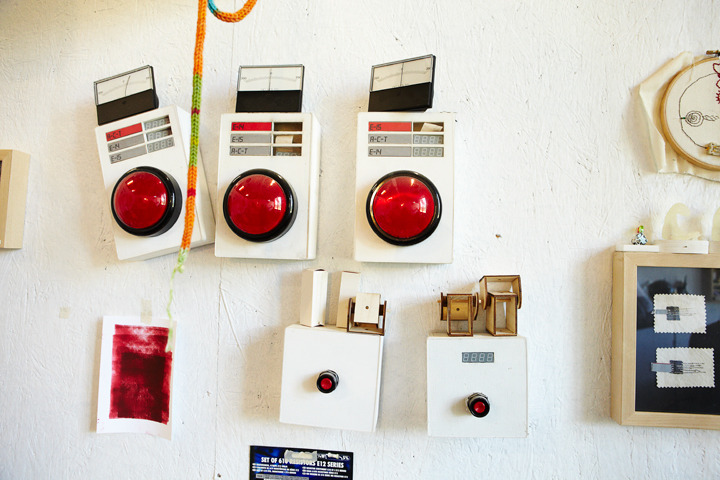This May The Creatives Project said farewell to resident Hannah Perner-Wilson as she accepted another residency abroad. But having already begun collaborative work with fellow TCP artist Justin Rabideau and Artist-in-Studio alternate Jerushia Graham (some of which will come to fruition this summer during TCP's outreach with One Love Generation), Hannah's legacy will live on as Jerushia takes up residence in her absence. As TCP prepares for this creative changing of the guard, it seemed like the perfect time to give both artists a proper Creative Process introduction to see where TCP is taking both of them in the near future.
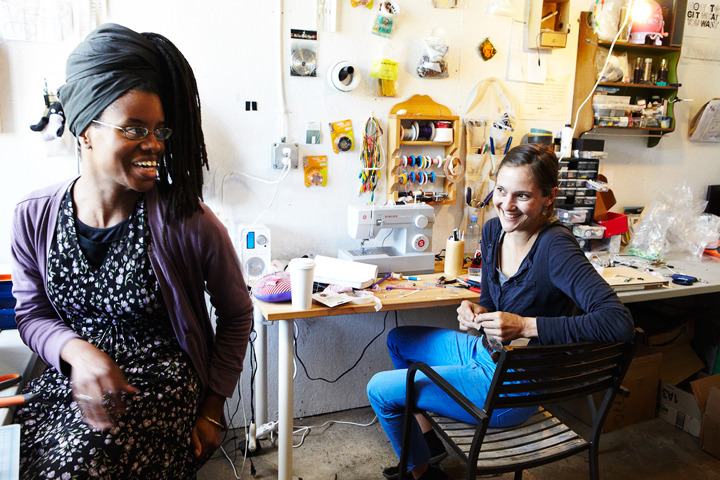 Jerushia Graham (left) and Hannah Perner Wilson collaborating in Hannah's TCP studio.
Jerushia Graham (left) and Hannah Perner Wilson collaborating in Hannah's TCP studio.
You're both resident Artists-in-Studio for TCP. How has that benefited you creatively?
Hannah: For me it was great because I just moved to Atlanta last September and I set up my studio at home. One day I realized that it was really depressing to be at home all day by myself. I didn't know anyone in Atlanta and I wasn't meeting anyone, so I started Googling for studio spaces to rent. I came across TCP's call to artists while searching for a studio space so I applied for it. Getting it made a huge difference because I moved my studio to the Goat Farm and met everyone else who was part of the TCP residency program and others at the Goat Farm.
Jerushia: I had attended a Gather Atlanta meeting and was representing the Atlanta Printmakers Studio. TCP had a table there, so that's how I found out about it. I decided to apply because I had parts and pieces of stuff at my house and portions of things at my parents' frame shop [Final Touch Frame Shop in Jonesboro] and I just needed a space where I could spread out and know that I wasn't going to get interrupted. It's been beneficial to me for that reason, but also getting to meet other artists that I didn't know and getting to know the Goat Farm. I had heard about things going on there, but I had never been there. We're actually doing collaborative work because I met Hannah and Justin Rabideau through The Creatives Project.
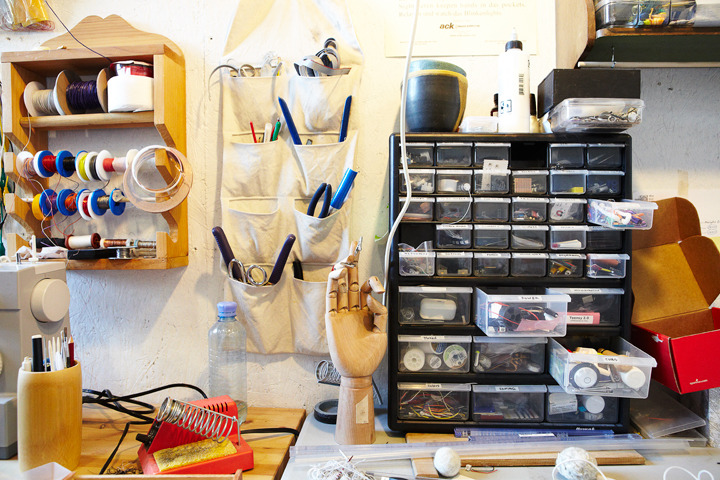
Tell me about the work you've been working on together.
Jerushia: We're playing with automatons and objects that invite you to physically interact with them. So you can wind something or press a button and that might turn something or engage a small motor.
We're really excited about the concept we created for FLUX, we are continuing to build the project for a future showing. [TCP founder] Neda [Abghari]'s helping us locate a space to exhibit it.
Hannah: What's nice is that we can sit down in the same space and work side-by-side. When we started writing the proposal, we just met and talked. But we didn't actually start working on anything until we came up with these great ideas and this huge project. It actually can become very different when you sit down to work something out. Ideas change during the process, so that's where we're at right now.
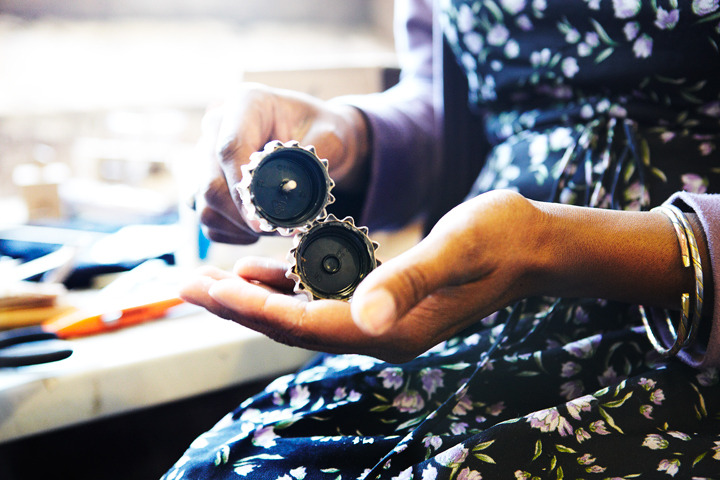
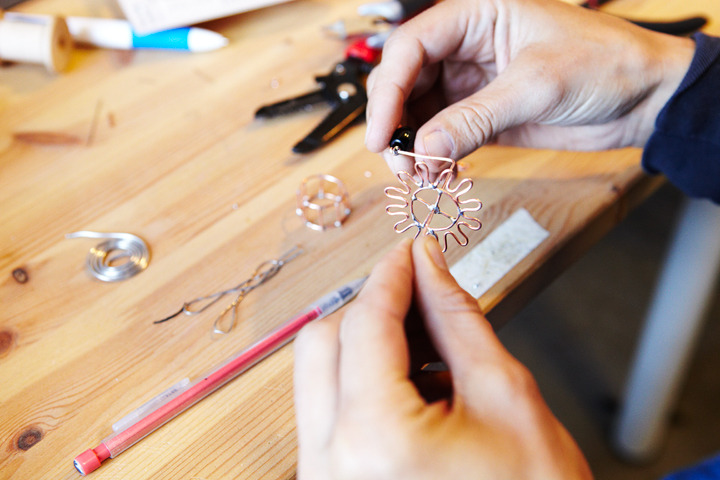
Hannah, you're leaving TCP because you've been accepted into another residency abroad. Where are you headed?
Hannah: When I first moved here I planned to stay for at least a few years. Then work and collaboration opportunities came up in europe and I decided to move back to Berlin. Before leaving, I'm going to San Francisco to collaborate with some people at UC, Berkeley. Then I'll be in Vienna for a residency to create a new piece for a show. Then I'm going to Sweden on a grant to do another piece. So I won't be moving to Berlin until October.
While in Atlanta, working at the Goat Farm, I've spent a lot of time working on a pair of gloves for London-based musician Imogen Heap. The gloves have bend sensors integrated for each finger-joint so that they can detect movements and postures of her hands in order that she can control her digital music software more expressively. The whole gloves project was realized by an amazing team, and there is a wonderful "making-of" documentary that can be viewed online. Imogen performed live for the first time with the gloves in April, and the song titled Me the Machine will hopefully be released by the end of June.
You also recently worked on the Rua | Wülf, a play based on Little Red Riding Hood produced by another Goat Farm-based group called Saïah. What was your contribution to that show?
Hannah: I got to know Tian Justman, who is a fashion designer with a studio at the Goat Farm, and she along with Saïah sent out an open call to all the artists at the Goat Farm to read the script and come up with ideas for scenes or costumes. One idea they kind of already had was that the cape that Rua wears lights up in one scene where she becomes of age. So Tian had designed the cape and another artist had painted panels attached to the cape and I embedded LED lights into the fabric. I designed the circuitry to be a nice visual element, then programmed the lights and figured out how the actress could trigger the lights during the scene. It should seem like the lights are coming on with her change of mind or mood and not look like she's pressing a button to make the lights become more and more intense as she is aroused. So we made some soft switches in the cape where she could just squeeze the fabric to control the lights. It was nice because I got to work a lot in Tian's studio, which is a really nice studio, and work with the people in the production and lots of the actors. It was fun to get to see bits and pieces of the play before actually seeing the whole thing.
Jerushia, you were an alternate who will be taking Hannah's spot in TCP now that she's leaving. How will that change the way you've been involved with TCP up to this point?
 Jerushia: The way the alternate position works is you're not given a space unless one becomes available, however, you're still included in TCP exhibitions and promotion for it's artists. I participated in TCP's show last October at the Goat Farm and the work that I had in that show was a combination of relief printing, paper cuts and stitching. My background is in printmaking and fabric design, so I try and marry all the things that I like to do. That's pretty much what I've been working on until we started collaborating. With the collaborative work, we've been teaching ourselves through trial and error how to build mechanisms. So the stuff I'm working on now is related to making mechanisms visually interesting, not just because there's motion involved but with some added visual reward.
Jerushia: The way the alternate position works is you're not given a space unless one becomes available, however, you're still included in TCP exhibitions and promotion for it's artists. I participated in TCP's show last October at the Goat Farm and the work that I had in that show was a combination of relief printing, paper cuts and stitching. My background is in printmaking and fabric design, so I try and marry all the things that I like to do. That's pretty much what I've been working on until we started collaborating. With the collaborative work, we've been teaching ourselves through trial and error how to build mechanisms. So the stuff I'm working on now is related to making mechanisms visually interesting, not just because there's motion involved but with some added visual reward.
How will you continue your collaboration in Hannah's absence?
Hannah: I guess we don't quite know, but the way we've set ourselves up for building it is it's a series of mechanized boxes that can be installed. So we can work on them separately and bring them together at a later point. They're based on found objects, so we'll all be able to find found objects wherever we are.
Jerushia: There's also a fourth artist who is a costume designer in New York. She's originally from Jonesboro, where I live. So we're just bringing together all of our unique talents to see what comes of it.
What can you tell our readers about your work and where can people find out more about it online?
Hannah: With my work I document a lot of the processes that I go through in making what I do. So I developed these techniques where I build something, I document it, then I turn it into a how-to instruction set for a project and post it online. I have a website called How to Get What You Want, which is all about bringing fabrics and electronics together and building sensors out of knitting steel yarn or felting steel wool or weaving and sewing circuits with conductive thread. Then I have my own website Plusea.at, where I document my projects without the how-to part.
Jerushia: ArtbyJerushia.com documents my work through 2011. In terms of subject matter, my work is currently focused on the spirituality of craft. There's something that we transfer to the objects we make that come through to other people. When you've made something you've given them or made something they're using, I feel like there's a spirit that people years from now will encounter. Part of the series that I showed in October and that I've continued working on is called The Spirit House series.
Where might people find your work around Atlanta?
Jerushia: The Spirit House work is on exhibit now at The Chocolate Bar in Decatur through the end of the month. I have a quilted piece inspired by the prints up at the Southwest Arts Center through the end of next month. It was part of a show called Camouflage II, which was a collaboration between visual artists and dancers. The visual artists were curated, then a choreographer came in and created dances inspired by the visual work. On the night of the opening, the dancers were painted to actually camouflage with the artwork, then went on stage and performed the dances.
This summer Jerushia will be teaching a special workshop as a part of her TCP outreach with One Love Generation. Spaces are still open for youth and teen participants!
Check out the details:
SPEAK OUT! Street Puppet Workshop
1200 Foster St. NW Building B-11 Atlanta, GA 30318 [The Goat Farm]
June 25-30, 2012, 10a - 4p
Video Session Saturday June 30 open to the public
People around the world have used street puppets to mobilize communities and large groups around a common cause or celebration. Come learn to build giant puppets and props. We will invite our friends, families, and communities to help us use these impressive creations to create a short video. The video will be used to speak out against bullying. You'd be surprised how much fun and how engaging taking a stand can be. Help One Love Generation speak out against bullying by signing up for the SPEAK OUT! Street Puppet Workshop.
Contact Jennifer Lester: jennifer@onelovegeneration.org, 424-229-1536
article by Jonathan Williams photography by: Neda Abghari


